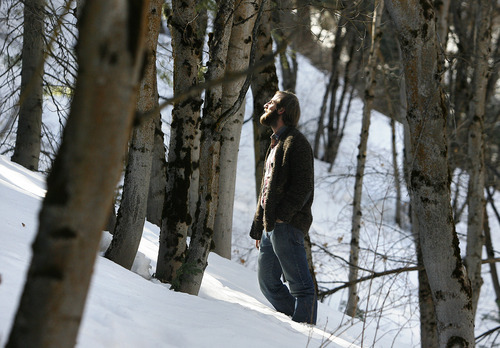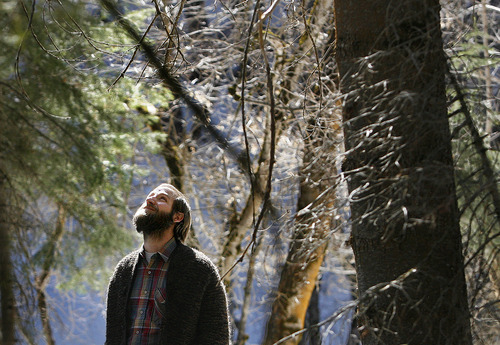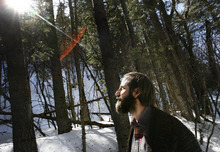This is an archived article that was published on sltrib.com in 2012, and information in the article may be outdated. It is provided only for personal research purposes and may not be reprinted.
Jason Brown was a Brigham Young University anthropology student working on a Guatemalan field study when he sensed that his spirituality and the natural world were tightly bound.
The villagers he was living among had a vastly different view of a forest than most Americans. Thinking the trees around them were neither a dollar-valued commodity nor a nature preserve to be admired but kept separate, they cherished them for the firewood, shelter, animals and comfort they provided.
Their ways led Brown to a new path with dual theology and forestry master's degrees from Yale University and helped inform the environmental conscience that he discusses in religion and ethics and values classes he leads at Utah Valley University and Salt Lake Community College.
It's a philosophy that embraces the divine inspiration found in any part of nature — from a Wasatch Range spruce forest to a backyard garden.
"You say, 'What's nature?' And they say, 'Well, my cornfield. My house,' " Brown said. "There wasn't this [separate] category called nature."
Environmental ethics and a reverence for landscapes are common bonds among many faiths in Utah. The conspicuous beauty of the state's mountains, forests and deserts makes the theme almost unavoidable, said Pastor Jeffrey Louden of St. Matthew's Lutheran Church in Taylorsville. He noted that many congregations throughout the Salt Lake Valley are active in fighting climate change or protecting landscapes, with a newsworthy example last year being First Unitarian Church's support of fellow congregant Tim DeChristopher as he was convicted for obstructing an oil and gas lease sale in protest of Bush administration drilling policies. Like Brown, Louden finds the sacred wherever he seeks it — and not just in politically protected places. He believes even urban landscapes such as Salt Lake City's 700 East ("there are a lot of animals downtown") can be sacred.
"The world is a gift," Louden said, "so therefore it's sacred." Perhaps it's a product of our species' evolution in nature. "People feel most at home when they feel connected to the environment."
Louden is also a National Outdoor Leadership School instructor, for which he will lead a hiking expedition into Wyoming's Wind River Mountains this summer. It's another way of sharing his love of the world, and it's what he does instead of feeling frustrated by others' indifference to the land.
"Can't go there," he said when asked whether Utahns sufficiently respect their environment. "Frustration doesn't motivate anybody. All I can do is go places, show people and motivate them."
Brown said an industrial or utilitarian outlook corrodes the nature-spirit connection, and he's troubled by this attitude in Utah. The Guatemalan farmers told him of the old stories — stories that many no longer believe as modern culture has overtaken their land — of trees having spirits.
These stories struck a nerve with Brown, a young Mormon who wondered why so many of his own faith seemed oblivious to church founder Joseph Smith's view of nature: that animals and plants have spirits.
He wondered why Western society had so commodified the land — some of it for products, other parts for parks and wildernesses — when Smith's "first vision" of God occurred in a most natural place: a wooded farm his family had not only tapped for timber and maple syrup, but also revered as a shelter for worshipful contemplation.
While finishing at Yale last summer, Brown visited Smith's "sacred grove" in Palmyra, N.Y., and further developed his take on sacred groves everywhere. He interviewed visitors about their experiences there among the hardwoods. Some were history buffs. Some made annual pilgrimages. Some assigned a particular sacredness to those specific trees.
For his part, Brown finds the sacred everywhere because he views sacredness as a process or experience. Smith sought clarity in nature, he said, and in so doing taught followers to bring their own questions to nature.
"Spiritual nutrition is accessible everywhere," he said. "All groves are sacred."
That's why he believes more people, including more Mormons, should be mindful of nature's intrinsic value. Using forests and other places in sustainable ways is part of incorporating the land into the human consciousness, he said, but too often Americans value resources only for their monetary value.
Ideally he supports greater local control of public lands, noting that previous generations of federal foresters from Washington brought a utilitarian mind-set to their timber-management task. But he also hopes church leaders will increasingly focus attention on stewardship issues. It's a hope he said has gained some traction as top Mormon leaders have begun building greener, more energy-efficient meetinghouses.
George Handley, a humanities professor at BYU, has written about the spirituality of place and nature in his book Home Waters, about his life and wanderings along the Provo River. He, too, finds the sacred in all of nature, but most especially close to home.
"We make places spiritual by the experiences we have in them," he said. "Any place has the potential to be a spiritual place if we bring a kind of reverence to it and respect or maybe even awe to it."
Often these experiences start with family or friends and shared events outdoors, he said. But aloneness in nature also heightens perception. Even dangers demonstrating vulnerability — close calls such as losing one's way in the desert — have value in that they make one feel alive and aware. Sometimes that may even be the subconscious goal of an outing.
"Modern life is so automated," Handley said, "and it really doesn't cultivate that awareness of our senses very well."
Handley called the concept of sacred natural places "a beautiful idea" and, like Brown, he pointed out that Smith found his in the neighboring trees, not "some exotic locale."
"The fact that that [grove] is sacred should be an emblem of why any place where we live could have that sort of sacred quality for us," he said. "We have to approach where we live with that kind of reverence."
Twitter: @brandon loomis —
Natural inspiration
• Moses
"And the Lord came down upon Mount Sinai, on the top of the mount:
and the Lord called Moses up to the top of the mount; and Moses went
up." Exodus 19:20
• Jesus
"And after six days Jesus taketh with him Peter, and James, and John,
and leadeth them up into an high mountain apart by themselves: and he
was transfigured before them." Mark 9:2
• Joseph Smith
"So, in accordance with this, my determination to ask of God, I
retired to the woods to make the attempt. It was on the morning of a
beautiful, clear day, early in the spring of 1820." Joseph Smith
History 1:14
• Henry David Thoreau
"I went to the woods because I wished to live deliberately, to front
only the essential facts of life, and see if I could not learn what
it had to teach, and not, when I came to die, discover that I had not
lived." Walden







